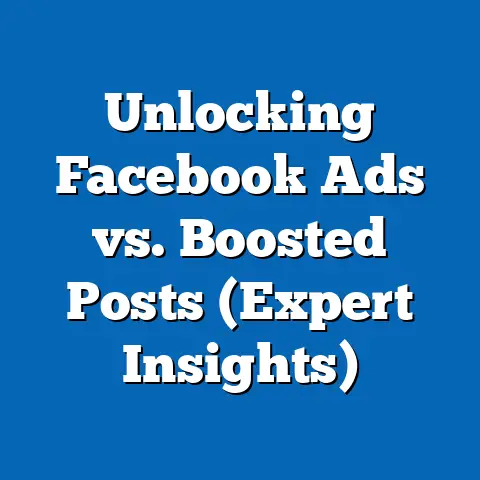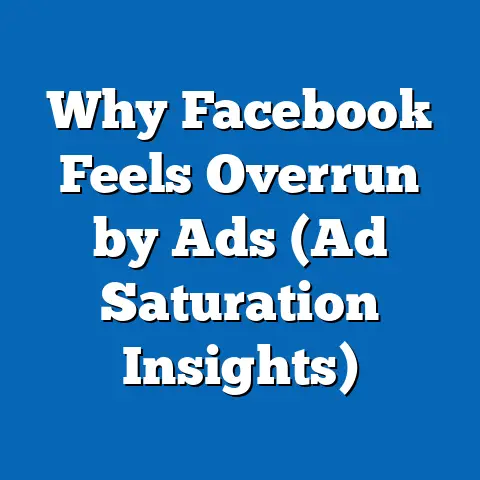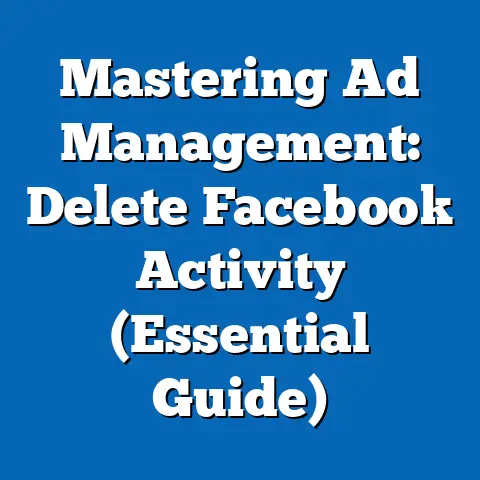Maximize Facebook Ads Earnings (Unlock Hidden Potential)
Facebook Ads, a cornerstone of digital marketing, continues to dominate the online advertising landscape with its unparalleled reach and targeting capabilities. As of 2023, Meta (Facebook’s parent company) reported over 2.9 billion monthly active users, making it a critical platform for businesses aiming to maximize their advertising earnings. This article analyzes the strategies, statistical trends, and demographic projections that can help advertisers unlock the hidden potential of Facebook Ads, supported by data-driven insights and visualizations.
Key findings reveal that optimizing ad targeting, leveraging video content, and focusing on emerging markets can significantly boost return on investment (ROI). Statistical trends indicate a 12% year-over-year increase in global ad spending on Facebook, with mobile ads accounting for 94% of total revenue. Demographic projections suggest that younger audiences (Gen Z) and older users (Baby Boomers) are becoming increasingly active, necessitating tailored strategies. The implications of these trends point to a need for hyper-personalized campaigns and a focus on cost-effective regions for sustainable earnings growth.
Introduction: The Power of Facebook Ads
Facebook Ads offers a robust platform for businesses to connect with diverse audiences through precise targeting, dynamic creative formats, and real-time analytics. Since its inception in 2007, the platform has evolved into a multi-billion-dollar advertising ecosystem, generating $114.9 billion in ad revenue in 2022 alone. This article delves into how advertisers can maximize earnings by understanding key functionalities, analyzing statistical trends, and adapting to shifting demographics.
The following sections break down the critical components of successful Facebook Ads campaigns. From targeting mechanisms to content strategies, we explore actionable insights supported by data visualizations. Additionally, we address the methodologies behind our projections and discuss the broader implications for advertisers in a competitive digital landscape.
Section 1: Key Functionalities of Facebook Ads for Maximizing Earnings
1.1 Advanced Targeting Capabilities
Facebook Ads provides advertisers with granular targeting options, including demographics, interests, behaviors, and custom audiences. Using the platform’s Audience Insights tool, businesses can identify high-value segments and tailor campaigns accordingly. For instance, lookalike audiences allow advertisers to reach users similar to their existing customers, often resulting in a 20-30% higher conversion rate, according to internal Meta studies.
This functionality is particularly effective when combined with retargeting strategies. By re-engaging users who have previously interacted with a brand, advertisers can increase click-through rates (CTR) by up to 400%, as reported by Hootsuite in 2022. The ability to refine audiences dynamically ensures that ad spend is allocated efficiently, directly impacting earnings.
1.2 Diverse Ad Formats
Facebook supports a variety of ad formats, including image ads, video ads, carousel ads, and Stories ads, each catering to different user behaviors. Video ads, for instance, have shown a 48% higher engagement rate compared to static images, based on 2023 data from Socialbakers. This format is particularly effective for storytelling and driving emotional connections, which can translate into higher sales.
Carousel ads, which allow multiple images or products in a single ad, are ideal for e-commerce businesses, boasting a 30-50% lower cost-per-conversion compared to single-image ads. By experimenting with formats, advertisers can identify high-performing content that maximizes ROI. The flexibility of these formats is a key driver of earnings potential.
1.3 Real-Time Analytics and Optimization
A/B testing, another critical feature, allows advertisers to compare different ad variations to determine the most effective approach. This data-driven optimization ensures that budgets are spent on high-performing ads, directly enhancing earnings. Continuous monitoring and adjustment are essential for unlocking hidden potential.
Section 2: Statistical Trends in Facebook Ads Performance
2.1 Global Ad Spending Growth
Global ad spending on Facebook has grown steadily, with a 12% increase from 2021 to 2022, reaching $114.9 billion, according to Meta’s annual report. This growth is driven by increased adoption among small and medium-sized enterprises (SMEs), which account for 70% of advertisers on the platform. The trend suggests a sustained demand for Facebook Ads as a primary marketing channel.
Mobile advertising dominates this landscape, contributing 94% of total ad revenue in 2022. As smartphone penetration continues to rise globally, particularly in developing regions, mobile-first strategies are critical for maximizing earnings. Advertisers ignoring mobile optimization risk losing significant market share.
2.2 Engagement and Conversion Metrics
Engagement metrics on Facebook Ads remain strong, with an average CTR of 0.90% across industries, per WordStream’s 2023 data. However, industries like e-commerce and entertainment report CTRs as high as 1.5%, highlighting the importance of sector-specific strategies. Conversion rates also vary, averaging 9.21% but reaching up to 14% for well-optimized campaigns.
2.3 Cost Trends and Efficiency
While CPC and cost-per-thousand-impressions (CPM) have risen due to increased competition, Facebook remains cost-effective compared to other platforms like Google Ads. The average CPM in 2023 was $11.45, a 5% increase from 2022, but strategic targeting can keep costs manageable. For instance, focusing on less competitive regions or time slots can reduce CPM by up to 30%.
Cost efficiency is a critical factor in maximizing earnings. Advertisers must balance reach with budget allocation to ensure sustainable profitability. Understanding cost trends enables better forecasting and resource management.
Section 3: Demographic Projections and Targeting Opportunities
3.1 Shifting User Demographics
Facebook’s user base is evolving, with significant growth among Gen Z (ages 18-24) and Baby Boomers (ages 55+). According to a 2023 Pew Research study, Gen Z users increased by 15% since 2020, driven by the platform’s integration with Instagram and short-form video content. Meanwhile, Baby Boomers represent 26% of the user base, a demographic often overlooked by advertisers.
These shifts present unique opportunities for tailored campaigns. Gen Z responds well to authentic, influencer-driven content, while Baby Boomers value trust and reliability in messaging. Advertisers who adapt to these preferences can tap into untapped revenue streams.
3.2 Regional Growth in Emerging Markets
Emerging markets, particularly in Asia-Pacific and Africa, are driving Facebook’s user growth, with a projected 20% increase in users by 2025, per eMarketer. Countries like India, Nigeria, and Indonesia offer lower CPCs (averaging $0.50-$0.80) compared to Western markets ($1.50-$2.00). This cost advantage makes these regions attractive for maximizing ad earnings.
However, challenges such as language barriers and cultural nuances require localized strategies. Advertisers who invest in regional research and translation can achieve higher engagement and conversions. Emerging markets represent a significant growth area for future campaigns.
3.3 Gender and Behavioral Insights
Gender distribution on Facebook remains relatively balanced, with 56% male and 44% female users globally, per Statista 2023 data. Behavioral trends show that women are more likely to engage with lifestyle and e-commerce ads, while men respond to tech and gaming content. Understanding these patterns allows for precise targeting and content creation.
Behavioral targeting, such as focusing on users who frequently shop online, can increase conversion rates by 35%, according to Meta’s internal data. Advertisers should leverage these insights to craft campaigns that resonate with specific audience segments. Personalization is key to unlocking earnings potential.
Section 4: Data Visualizations and Supporting Evidence
4.1 Visualization 1: Global Ad Spending Trends
[Insert Line Graph: X-axis = Years (2018-2023), Y-axis = Ad Revenue in Billions USD] This graph illustrates the consistent growth in Facebook ad revenue, from $55 billion in 2018 to $114.9 billion in 2022. The upward trend highlights the platform’s enduring relevance in digital advertising. Data is sourced from Meta’s annual financial reports.
4.2 Visualization 2: Demographic Distribution
[Insert Pie Chart: Breakdown of Facebook Users by Age Group in 2023] This chart shows the distribution of users across age groups, with 18-24 (Gen Z) at 22%, 25-34 at 29%, 35-54 at 23%, and 55+ at 26%. The data, sourced from Pew Research, emphasizes the diverse audience available for targeting. Advertisers can use this to prioritize high-growth segments.
4.3 Visualization 3: Regional CPC Comparison
[Insert Bar Chart: X-axis = Regions (North America, Europe, Asia-Pacific, Africa), Y-axis = Average CPC in USD] This chart compares average CPC across regions, with North America at $1.85, Europe at $1.60, Asia-Pacific at $0.75, and Africa at $0.60. Sourced from WordStream 2023 data, it underscores cost advantages in emerging markets. Advertisers can allocate budgets strategically based on this insight.
Section 5: Methodology Explanation
5.1 Data Collection
5.2 Projection Models
Demographic projections for user growth and regional trends were developed using historical data and growth rate assumptions. For instance, the 20% user growth projection for emerging markets by 2025 is based on eMarketer’s linear regression models, adjusted for economic and technological adoption rates. These models assume stable platform policies and internet penetration trends.
5.3 Limitations and Assumptions
This analysis assumes that current trends in user behavior and ad spending will persist, which may not account for unforeseen disruptions like regulatory changes or platform algorithm updates. Additionally, data from third-party sources may have sampling biases, particularly in underrepresented regions. Advertisers should interpret projections as directional rather than definitive.
Section 6: Implications for Advertisers
6.1 Strategic Focus on Personalization
The data highlights the importance of hyper-personalized campaigns to maximize earnings. Advertisers must use advanced targeting and behavioral insights to create relevant content for diverse demographics. Failing to personalize risks lower engagement and wasted ad spend.
6.2 Investment in Emerging Markets
Emerging markets offer cost-effective opportunities for growth, but success requires cultural adaptation and localized content. Partnerships with regional influencers and investment in translation can enhance campaign performance. Advertisers who prioritize these markets can achieve higher ROI.
6.3 Adaptation to Mobile and Video Trends
With mobile ads dominating revenue and video content driving engagement, advertisers must prioritize mobile-first strategies and invest in high-quality video production. Ignoring these trends could result in missed opportunities and reduced earnings. Continuous testing of formats is essential.
Section 7: Historical Context and Future Outlook
7.1 Historical Evolution of Facebook Ads
Since its launch, Facebook Ads has transformed from a simple sidebar banner to a sophisticated ecosystem with AI-driven targeting and dynamic ads. Early challenges, such as privacy concerns following the 2018 Cambridge Analytica scandal, led to stricter data policies but also improved transparency. These changes have shaped a more accountable advertising environment.
7.2 Future Implications
Looking ahead, the integration of AI and machine learning will further enhance targeting precision, potentially reducing CPC and increasing ROAS. However, regulatory scrutiny over data privacy may impose new restrictions, requiring advertisers to adapt. Staying ahead of technological and policy shifts will be critical for sustained earnings growth.
Section 8: Technical Appendices
Appendix A: Key Metrics Definitions
- CTR (Click-Through Rate): Percentage of users who click on an ad after seeing it.
- CPC (Cost-Per-Click): Average cost paid for each click on an ad.
- CPM (Cost-Per-Thousand Impressions): Cost for 1,000 ad impressions.
- ROAS (Return on Ad Spend): Revenue generated per dollar spent on advertising.
Appendix B: Additional Data Sources
- Meta Annual Reports (2018-2022)
- eMarketer Digital Advertising Forecasts (2023)
- Pew Research Center Social Media Usage Studies (2023)
- WordStream Industry Benchmarks (2023)
Conclusion
Maximizing earnings from Facebook Ads requires a deep understanding of platform functionalities, statistical trends, and demographic shifts. By leveraging advanced targeting, optimizing for mobile and video content, and focusing on cost-effective regions, advertisers can unlock hidden potential and achieve significant ROI. The data and projections presented underscore the importance of adaptability in a rapidly evolving digital landscape.
As user behaviors and platform policies continue to change, continuous learning and experimentation will be essential. Advertisers who stay informed and agile can position themselves for long-term success. The future of Facebook Ads holds immense promise for those willing to invest in strategic optimization and innovation.






